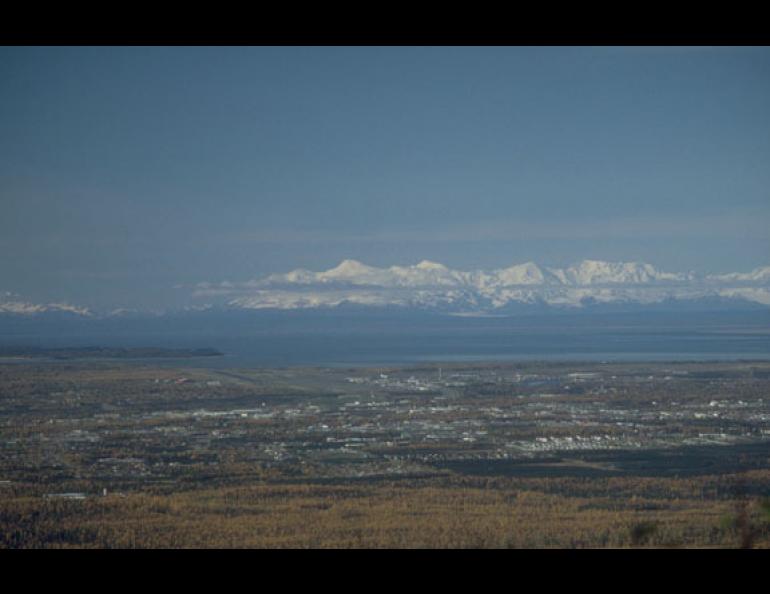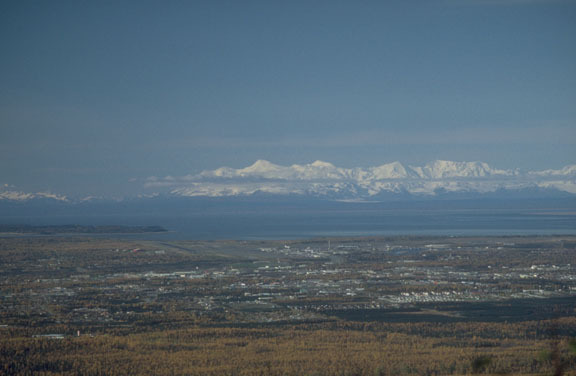
Golden Anniversary of Anchorage's First Blackout
Fifty years ago, the Anchorage Daily News reported on unrest in the Middle East, a crash in the returning Bristol Bay red salmon population, war on the Korean peninsula, and the hazard of residing across Cook Inlet from some of the world’s most active volcanoes.
“City in Total Darkness as Eruptions Rage,” was the banner across the July 9, 1953 edition. Mount Spurr, located 78 miles west of Anchorage, had erupted, and a western wind carried much of the ash over Alaska’s largest city.
“Residents of this area carried on their normal pursuits today in spite of the ‘strange darkness’ and persistent ash fall caused by this morning’s eruptions,” a reporter wrote. By 1 p.m. on the afternoon of the eruption, Anchorage had experienced a “total blackout.” Even small amounts of ash can contaminate water supplies, close roads and airports, and cause health problems. The Army Air Corps moved most of its aircraft from Elmendorf to other air bases in Alaska, and mothers were keeping their children indoors because “the gritty mineral ash was causing sore eyes.”
The 1953 Mount Spurr eruption was urban Alaska’s introduction to the disruption of regular life that could happen on any day in areas downwind from Alaska’s active volcanoes, said Tom Murray, the scientist-in-charge at the Alaska Volcano Observatory in Anchorage.
“The ash hazard will always be there,” Murray said. “When people just move here, they think all those pretty mountains across Cook Inlet are like the Cascades (in Oregon),” Murray said. “Mount Hood’s a volcano, sure, but it hasn’t gone off in 200 years. These erupt about once every ten years.”
Volcanoes in the neighborhood of Anchorage and the Kenai Peninsula include Mount Hayes, Spurr, Redoubt, Iliamna, and Augustine. All except Iliamna and Hayes have erupted since 1986. Mount Redoubt, sitting across Cook Inlet 50 miles from the Kenai Peninsula, made headlines in December 1989 when its ash plume disabled all four engines of a Boeing 747 descending in to Anchorage. The pilot and copilot scrambled to restore power and landed the plane safely after flying through the cloud, but investigators later found the engines coated with glassy deposits caused by ash melting and then solidifying.
On August 18, 1992, three years after the Mount Redoubt eruption, Mount Spurr spewed so much gritty ash into the air over southcentral Alaska that automatic streetlights turned on hours before sunset. Mount Spurr erupted three times in 1992.
Fifty years ago, a few days after the 1953 Mount Spurr eruption, a group of scientists flew from Anchorage to Spurr’s summit to study the eruption. Scientists today have the advantage of a seismometer network installed on and around more than 20 Alaska volcanoes. That allows volcanologists to record the internal rumblings of the volcanoes from their offices in Anchorage and Fairbanks. Collectively known as the Alaska Volcano Observatory, this network involves a collaboration of scientists from the Geophysical Institute, the U.S. Geological Survey, and the Alaska Division of Geological and Geophysical Surveys. In addition to seismometers buried around volcanoes, today’s scientists also use satellites to monitor volcano hot spots, eruptions, and ash clouds, and have developed computer models to track ash plumes.
In 1953, two pilots discovered the Mount Spurr eruption because they happened to be flying over the southwest Alaska Range. Today, scientists at the volcano observatory track the moods of volcanoes and issue weekly reports of increased seismic activity to aviators, emergency-management groups, and anyone who logs on to www.avo.alaska.edu.
Scientists have learned a great deal about volcanoes since Mount Spurr dumped ash on Anchorage 50 years ago, but, like political instability and the booms and busts of salmon runs, the threat from Alaska volcanoes is the same as it was a half century ago.
“An eruption could happen anytime,” Murray said, “but unlike 1953, it shouldn’t catch us by surprise.”





